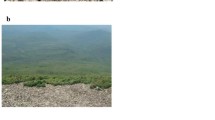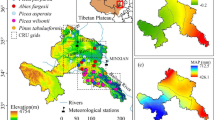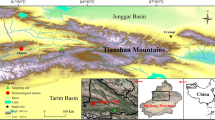Abstract
Recent temperature rise caused by human activities has led to profound changes in the forest ecosystem. Shrubs play an important role in the boreal forest. However, it is not clear how shrub growth responds to climate change, especially whether there is a difference in the response of shrub at different altitudes to climate change. Here, we developed three ring-width chronologies of Pinus pumila along an altitudinal gradient in the Aokelidui Mountains, northeast China, then analyzed the relationship between the growth of P. pumila and climate at different altitudes. The results showed that the radial growth of P. pumila at low altitude had more prominent climate signals than those at medium and high altitude and was more sensitive to climate change. The chronological similarity was the highest in low and middle altitudes (72.5%, p < 0.01). Summer temperature had a significant negative effect on the growth of shrubs, and summer precipitation was conducive to the formation of wider rings at medium altitude. The warmer winter of the previous year favored P. pumila growth at low and medium altitudes but just the opposite at high altitudes. After rapid warming, the negative correlation between temperature and P. pumila growth in the growing season changed to a positive correlation at high altitude. On the contrary, the relationship between precipitation and P. pumila growth in the growing season changed from a positive to a negative correlation. We also found that the sensitivity of the growth of P. pumila to the Standardized Precipitation Evapotranspiration Index (SPEI) has gradually increased at medium-altitude since the 1980s. Therefore, in recent decades, the effect of moisture on the radial growth of shrub has become more and more important at medium altitudes. At the same time, the temperature rise was beneficial to the growth of P. pumila at low altitude. Our results suggest that the treeline advancement in this area is unlikely to occur in the near future since the shrub at high altitudes is not sensitive to climate warming.







Similar content being viewed by others
References
Andivia E, Madrigalgonzalez J, Villarsalvador P, Zavala MA (2018) Do adult trees increase conspecific juvenile resilience to recurrent droughts? Implications for forest regeneration. Ecosphere 9:1–13
Biondi F, Waikul K (2004) DENDROCLIM2002: A C++ program for statistical calibration of climate signals in tree-ring chronologies. Comput Geosci 30:303–311
Bräuning A, Mantwill B (2004) Summer temperature and summer monsoon history on the Tibetan plateau during the last 400 years recorded by tree rings. Geophys Res Lett 31:1–4
Bunn AG (2008) A dendrochronology program library in R (dplR). Dendrochronologia 26:115–124
Buras A, Wilmking M (2015) Correcting the calculation of Gleichläufigkeit. Dendrochronologia 34:29–30
Camarero JJ, Gazol A, Galván JD, Sangüesa-Barreda G, Gutiérrez E (2015) Disparate effects of global-change drivers on mountain conifer forests: warming-induced growth enhancement in young trees vs. CO2 fertilization in old trees from wet sites. Glob Chang Biol 21:738–749
Chaves MM, Maroco JP, Pereira JS (2003) Understanding plant responses to drought: from genes to the whole plant. Funct Plant Biol 30:239–264
Clarke AG, Lord JM, Hua X, Ohlemüller R (2018) Does current climate explain plant disjunctions? A test using the New Zealand alpine flora. J Biogeogr 45:1490–1499
Cook ER, Holmes RL (1986) User’s manual for program ARSTAN. Laboratory of Tree-Ring Research University of Arizona, Tucson
Cook ER, Kairiukstis LA (1990) Methods of dendrochronology: applications in the environmental sciences. Arct Alp Res 23:245–251
Crimmins SM, Dobrowski SZ, Greenberg JA, Abztzoglou JT, Mynsberge AR (2011) Changes in climatic water balance drive downhill shifts in plant species’ optimum elevations. Science 331:324–327
Cullen LE, Stewart GH, Duncan RP, Palmer JG (2001) Disturbance and climate warming influences on New Zealand Nothofagus tree-line population dynamics. J Ecol 89:1061–1071
Ewers FW, Schmid R (1981) Longevity of needle fascicles of Pinus longaeva (Bristlecone pine) and other North American pines. Oecologia 51:107–115
Firm D, Nagel TA, Diaci J (2009) Disturbance history and dynamics of an old-growth mixed species mountain forest in the Slovenian Alps. For Ecol Manag 257:1893–1901
Fritts HC, Vaganov EA, Sviderskaya IV, Shashkin AV (1991) Climatic variation and tree-ring structure in conifers: empirical and mechanistic models of tree-ring width, number of cells, cell size, cell-wall thickness and wood density. Clim Res 1:97–116
Fritts HC (1976) Tree Rings and Climate. Academic Press, London
Götmark F, Götmark E, Jensen AM (2016) Why be a shrub? A basic model and hypotheses for the adaptive values of a common growth form. Front Plant Sci 7:1095–1108
Gou X, Chen F, Yang M, Li J, Peng J, Jin L (2005) Climatic response of thick leaf spruce (Picea crassifolia) tree-ring width at different altitudes over Qilian Mountains, northwestern China. J Arid Environ 61:513–524
Grace J, Allen SJ, Wilson C (1989) Climate and the meristem temperatures of plant communities near the tree-line. Oecologia 79:198–204
Hamed KH, Rao AR (1998) A modified Mann-Kendall trend test for autocorrelated data. J Hydrol 204:182–196
Harsch MA, Buxton R, Duncan RP, Hulme PE, Wardie P, Wilmshurst J (2012) Causes of tree line stability: stem growth, recruitment and mortality rates over 15 years at New Zealand Nothofagus tree lines. J Biogeogr 39:2061–2071
He M, Yang B, Bräuning A (2013) Tree growth–climate relationships of Juniperus tibetica along an altitudinal gradient on the southern Tibetan Plateau. Trees 27:429–439
Holmes RL (1983) Computer-assisted quality control in tree-ring dating and measurement. Tree Ring Bull 44:69–75
Huang R, Zhu H, Liang E, Grießinger J, Dawadi B, Bräuning A (2019) High-altitude shrub-ring δ18O on the northern slope of the central Himalayas records summer (May–July) temperatures. Palaeogeogr Palaeocl 524:230–239
IPCC (2014) Summary for policymakers of climate change 2013: the physical science basis. In: Contribution of working group I to the fifth assessment report of the intergovernmental panel on climate change. Cambridge University Press, Cambridge
Jacoby GC, D’Arrigo R (1995) Tree-ring width and density evidence of climatic and potential forest change in Alaska. Glob Biogeochem Cycles 9:227–234
Kajimoto T (1994) Aboveground net production and dry matter allocation of Pinus pumila forests in the Kiso mountain range, central Japan. Ecol Res 9:193–204
Khomentovsky PA (2004) Ecology of Siberian Dwarf Pine Pinus Pumila (Pallas) regel in Kamchatka. Science Publishers, Enfiled
Körner C, Hiltbrunner E (2018) The 90 ways to describe plant temperature. Perspect Plant Ecol 30:16–21
Kueppers LM, Conlisk E, Castanha C, Moyes AB, Germino MJ, Valpine PD, Torn AS, Mitton JB (2017) Warming and provenance limit tree recruitment across and beyond the elevation range of subalpine forest. Glob Chang Biol 23:2383–2395
Lenoir J, Gegout JC, Guisan A, Vittoz P, Wohlgemuth T, Zimmermann NE, Dullinger S, Pauli H, Willner W, Svenning J (2010) Going against the flow: potential mechanisms for unexpected downslope range shifts in a warming climate. Ecography 33:295–303
Li M, Yang J (2004) Effects of microsite on growth of Pinus cembra in the subalpine zone of the Austrian Alps. Ann Forest Sci 61:319–325
Liang E, Eckstein D (2009) Dendrochronological potential of the alpine shrub Rhododendron nivale on the south-eastern Tibetan Plateau. Ann Bot-London 104:665–670
Liang E, Wang Y, Eckstein D, Luo T (2011) Little change in the fir tree-line position on the southeastern Tibetan Plateau after 200 years of warming. New Phytol 190:760–769
Liu B, Liang E, Liu K, Camarero JJ (2018) Species-and elevation-dependent growth responses to climate warming of mountain forests in the Qinling Mountains, central China. Forests 9:1–11
Liu H, Williams AP, Allen CD, Guo D, Wu X, Anenkhonov OA, Liang E, Sandanov DV, Yin Y, Qi Z, Badmaeva NK (2013) Rapid warming accelerates tree growth decline in semi-arid forests of Inner Asia. Glob Chang Biol 19:2500–2510
Liu J, Deng X, Lyu LX (2015) Relationship of tree growth and climatic factors at treeline of Picea likiangensis var. Balfouriana forest in Basu County. Xizang Chin J Plant Eco 39:442–452
Lloyd AH, Bunn AG, Berner L (2011) A latitudinal gradient in tree growth response to climate warming in the Siberian taiga. Glob Chang Biol 17:1935–1945
Lyu L, Suvanto S, Nöjd P, Henttonen HM, Mäkinen H, Zhang Q (2017) Tree growth and its climate signal along latitudinal and altitudinal gradients: comparison of tree rings between Finland and the Tibetan Plateau. Biogeosciences 14:3083–3095
Matisons R, Purina L, Adamovics A, Robalte L, Jansons A (2017) European beech in its northeasternmost stands in Europe: varying climate-growth relationships among generations and diameter classes. Dendrochronologia 45:123–131
Martin-Benito D, Pederson N (2015) Convergence in drought stress, but a divergence of climatic drivers across a latitudinal gradient in a temperate broadleaf forest. J Biogeogr 42:925–937
Matías L, Linares JC, Sánchez-Miranda Á, Jump AS (2017) Contrasting growth forecasts across the geographical range of Scots pine due to altitudinal and latitudinal differences in climatic sensitivity. Glob Change Biol 23:4106–4116
McDowell NG, Allen CD, Marshall L (2010) Growth, carbon-isotope discrimination, and drought-associated mortality across a Pinus ponderosa altitudinal transect. Glob Change Biol 16:399–415
Mcmanus KM, Morton DC, Masek JG, Wang D, Sexton JO, Nagol IR, Ropars P, Boudreau S (2012) Satellite-based evidence for shrub and graminoid tundra expansion in northern Quebec from 1986 to 2010. Glob Chang Biol 18:2313–2323
Mitchell TD, Jones PD (2005) An improved method of constructing a database of monthly climate observations and associated high-resolution grids. Int J Climatol 25:693–712
Monserud RA, Sterba H (1996) A basal area increment model for individual trees growing in even- and uneven-aged forest stands in Austria. For Ecol Manag 80:57–80
Myers-Smith IH, Elmendorf SC, Beck PS, Wilmking M, Hallinger M, Blok D, Tape KD, Rayback SA, Macias-Fauria M, Forbes BC, Speed JDM, Boulanger-Lapointe N, Rixen C, Lévesque E, Schmidt NM, Baittinger C, Trant AJ, Hermanutz L, Collier LS, Dawes MA, Lantz TC, Weijers S, Jørgensen RH, Buchwal A, Buras A, Naito AT, Ravolainen V, Schaepman-Strub G, Wheeler JA, Wipf S, Guay KC, Hik DS, Vellend M (2015) Climate sensitivity of shrub growth across the tundra biome. Nat Clim Change 5:887–892
Okuda M, Sumida A, Ishii H, Vetrova VP, Hara T (2008) Establishment and growth pattern of Pinus pumila under a forest canopy in central Kamchatka. Ecol Res 23:831–840
Pandey A, Badola HK, Rai S, Singh S (2018) Timberline structure and woody taxa regeneration towards treeline along latitudinal gradients in Khangchendzonga National Park, Eastern Himalaya. PLoS ONE 13:1–20
Pan H, Li M, Cai X, Wu J, Du Z, Liu X (2009) Responses of growth and ecophsiology of plants to altitude. Ecol Environ Sci 18:722–730
Pan Y, Birdsey RA, Fang J, Houghton R, Kauppi PE, Kurz WA, Phillips OL, Shvidenko A, Lewis SL, Canadell JG, Ciais P, Jackson RB, Pacala SW, McGuire AD, Piao S, Rautiainen A, Sitch S, Hayes D (2011) A large and persistent carbon sink in the world’s forests. Science 333:988–993
Pellizzari E, Camarero JJ, Gazol A, Granda E, Shetti R, Wilmking M, Moiseev P, Pividori M, Carrer M (2017) Diverging shrub and tree growth from the polar to the mediterranean biomes across the European continent. Glob Change Biol 23:3169–3180
Peng J, Li J, Wang T, Huo J, Yang L (2019) Effect of altitude on climate–growth relationships of Chinese white pine (Pinus armandii) in the northern Funiu Mountain, central China. Clim Change 154:273–288
Ponocná T, Spyt B, Kaczka R, Büntgen U, Treml V (2016) Growth trends and climate responses of Norway spruce along altitudeal gradients in East-Central Europe. Trees 30:1633–1646
Rozas V, DeSoto L, Olano JM (2009) Sex-specific, age-dependent sensitivity of tree-ring growth to climate in the dioecious tree Juniperus thurifera. New Phytol 182:687–697
Rubino DL, Mccarthy BC (2000) Dendroclimatological analysis of White Oak (Quercus alba L. Fagaceae) from an old-growth forest of Southeastern Ohio, USA. J Torrey Bot Soc 127:240–250
Saulnier M, Corona C, Stoffel M, Guibal F, Edouard JL (2019) Climate-growth relationships in a Larix decidua Mill. network in the French Alps. Sci Total Environ 664:554–566
Scherrer D, Körner C (2011) Topographically controlled thermal-habitat differentiation buffers alpine plant diversity against climate warming. J Biogeogr 38:406–416
Shao J, Du J, Li S, Huang Y, Liang W, Liao J (2019) Tree seedling distribution characteristics, regeneration mechanism and response to climate change in alpine treeline ecotone. J Appl Ecol 30:1–12
Stokes MA, Smiley TL (1968) An introduction to tree-ring dating. The University of Chicago Press, Chicago
Tai B (2012) The relationship between the growth of Larix gmelinii in the north alpine of Great Khingan and the climate change. Dissertation of the Northeast Forestry University, Harbin
Takahashi K, Aoki K (2015) Effects of climatic conditions on annual shoot length and tree-ring width of alpine dwarf pine Pinus pumila in central Japan. J Plant Res 128:553–562
Takahashi K, Hirosawa T, Morishima R (2012) How the timberline formed: altitudinal changes in stand structure and dynamics around the timberline in central Japan. Ann Bot-London 109:1165–1174
Takahashi K (2003) Effects of climatic conditions on shoot elongation of alpine dwarf pine (Pinus pumila) at its upper and lower altitudinal limits in central Japan. Arct Antarct Alp Res 35:1–7
Takahashi K (2006) Shoot growth chronology of alpine dwarf pine (Pinus pumila) in relation to shoot size and climatic conditions: a reassessment. Polar Biosci 19:123–132
Thapa UK, George SS (2019) Detecting the influence of climate and humans on pine forests across the dry valleys of eastern Nepal’s Koshi River basin. For Ecol Manag 440:12–22
Tomiolo S, Harsch MA, Duncan RP, Hulme PE (2016) Influence of climate and regeneration microsites on Pinus contorta invasion into an alpine ecosystem in New Zealand. AIMS Environ Sci 3:525–540
Vicente-Serrano SM, Beguería S, Lópezmoreno JI (2010) A Multiscalar drought index sensitive to global warming: the standardized precipitation evapotranspiration index. J Clim 23:1696–1718
Wang X, Pederson N, Chen Z, Lawton K, Zhu C, Han S (2019) Recent rising temperatures drive younger and southern Korean pine growth decline. Sci Total Environ 649:1105–1116
Wang Y, Pederson N, Ellison AM, Buckley HL, BradleyS C, Liang E, Camarero JJ (2016) Increased stem density and competition may diminish the positive effects of warming at alpine treeline. Ecology 97:1668–1679
Wilmking M, Juday GP, Barber VA, Zald HS (2004) Recent climate warming forces contrasting growth responses of white spruce at treeline in Alaska through temperature thresholds. Glob Change Biol 10:1724–1736
Xu C, Liu H, Anenkhonov OA, Korolyuk AU, Sandanov DV, Balsanova LD, Naidanov BB, Wu X (2017) Long-term forest resilience to climate change indicated by mortality, regeneration, and growth in semiarid southern Siberia. Glob Chang Biol 23:2370–2382
Yang R, Fan Z, Li Z, Wen Q (2018) Radial growth of Pinus yunnanensis at different altitudes and their responses to climatic factors in the Yulong Snow Mountain, Northwest Yunnan, China. Acta Ecol Sin 38:8983–8991
Yu J, Liu Q (2018) Larix olgensis growth–climate response between lower and upper altitude limits: an intensive study along the eastern slope of the Changbai Mountains, northeastern China. J Forestry Res 31:231–244
Zhang Y, Wilmking M (2010) Divergent growth responses and increasing temperature limitation of Qinghai spruce growth along an altitude gradient at the northeast Tibet Plateau. For Ecol Manag 260:1076–1082
Zhu L, Cooper DJ, Yang J, Zhang X, Wang X (2018) Rapid warming induces the contrasting growth of Yezo spruce (Picea jezoensis var. microsperma) at two altitude gradient sites of northeast China. Dendrochronologia 50:52–63
Zhuang H, Liu Q, Meng S, Jia Q, Deng L (2015) Growth rhythm of Pinus pumila in Daxing’an Mountains, Inner Mongolia. J Cent South Univ for Technol 35:46–52
Zong S, Jin Y, Xu J, He H, Du H, Wang L (2016) Nitrogen deposition but not climate warming promotes Deyeuxia angustifolia encroachment in alpine tundra of the Changbai Mountains, Northeast China. Sci Total Environ 544:85–93
Acknowledgements
We thank Hao Wu, a staff member of the A’longshan Forestry Bureau for his great help in the fieldwork. Thanks to other lab students for their help in the experiment. We would also like to thank all anonymous reviewers for their valuable comments.
Funding
his research was supported by the Key Project of the China National Key Research and Development Program (2016YFA0600800), the National Natural Science Foundation of China (41877426 and 31971460), the Fundamental Research Funds for the Central Universities (2572017DG02 and 2572019CP15), and the Open Fund of Ecological-Meteorological Innovation Laboratory of China Meteorological Administration (stqx2018zd02).
Author information
Authors and Affiliations
Contributions
Conceptualization: JY, XW; Fieldwork: JY, XZ, WS; Formal analysis: JY, XW; Writing—original draft preparation: JY; Writing—review and editing: DJC, YZ, HZ, SH, XW.
Corresponding authors
Ethics declarations
Conflict of interest
The authors declare that no conflict of interest.
Additional information
Publisher's Note
Springer Nature remains neutral with regard to jurisdictional claims in published maps and institutional affiliations.
Supplementary Information
Below is the link to the electronic supplementary material.
Rights and permissions
About this article
Cite this article
Yang, J., Cooper, D.J., Zhang, X. et al. Climatic controls of Pinus pumila radial growth along an altitude gradient. New Forests 53, 319–335 (2022). https://doi.org/10.1007/s11056-021-09858-x
Received:
Accepted:
Published:
Issue Date:
DOI: https://doi.org/10.1007/s11056-021-09858-x




